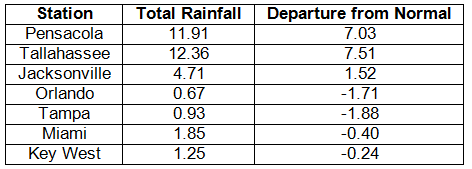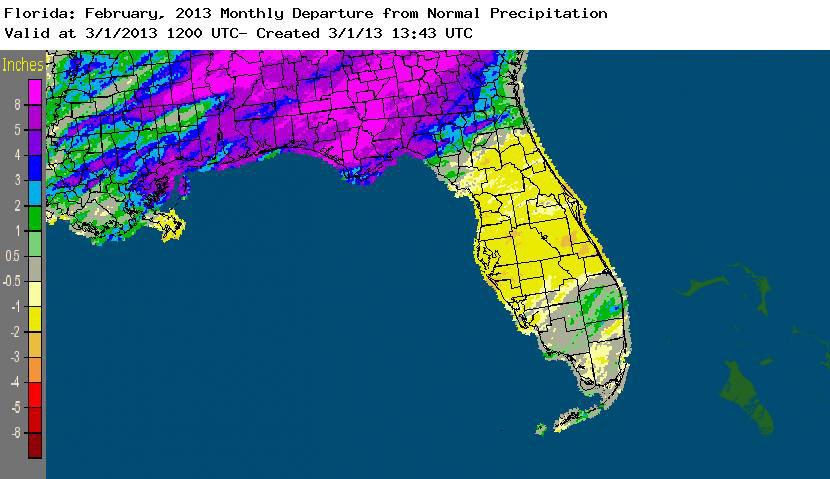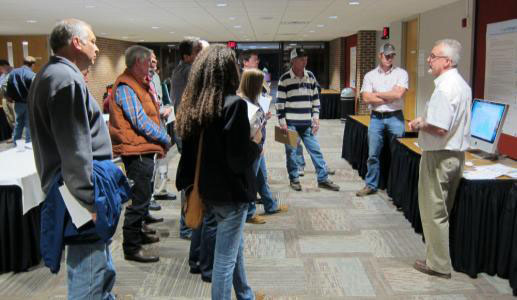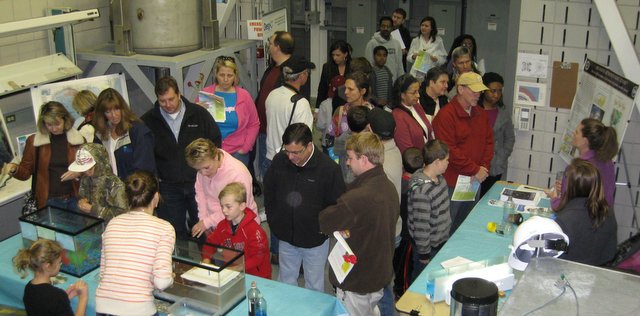Dear Florida Climate Center Friends,
We'd like to present you with the March 2013 edition of our newsletter. In this newsletter, you'll find our monthly climate summary, a list of special events that our staff attended, an example of a data request made to the office, and more. If you have any questions, please email us at climate@coaps.fsu.edu.
Thanks,
The Staff of the Florida Climate Center
 |  |  | David Zierden
State Climatologist | James O'Brien
Professor Emeritus | Melissa Griffin
Asst. State Climatologist |
|
|
Daylight Saving Time
Just a friendly reminder to everyone that Daylight Saving Time begins at 2:00 AM on Sunday, March 10th. Before you go to bed the night of the 9th, make sure to turn your clock ahead by one hour to reflect the change.
|
February Climate Summary for Florida
The Florida Climate Center's February 2013 Florida Climate Summary is now available. The summary provides an analysis of temperature and precipitation trends across the state, along with data on hazardous weather, drought, the impacts of the weather and any records tied or broken for the month. During February, average temperatures were above normal while rainfall totals varied in Florida. ENSO-neutral conditions are expected to continue through the spring. The Climate Prediction Center (CPC) predicts above normal temperatures and below normal precipitation for Florida through May. Past summaries are archived here.
| February average temperatures and departures from normal (° F) for select cities. |  |
| February precipitation totals and departures from normal (inches) for select cities. |  |
| A graphical depiction of the monthly rainfall departure from normal (inches) for February (courtesy of NOAA, NWS). |  |
|
|
 Climate Adaptation Exchange Climate Adaptation Exchange
The 2nd Annual "Climate Adaptation Exchange," held on February 8th in Tifton, GA, engaged more than 100 producers and extension specialists from Alabama, Florida, Georgia and South Carolina in presentations and discussions of management strategies that can make production systems more efficient and less susceptible to climate challenges. Both State Climatologist David Zierden and Assistant State Climatologist Melissa Griffin were in attendance to help answer climate-related questions and highlight their ongoing participation with the Southeast Climate Consortium's online climate risk decision support tool: AgroClimate. One of the goals for the Adaptation Exchange was that participants would learn how alternative management strategies can make production more efficient, profitable, and resilient to climate variability.
|
|
 Mag Lab Open House Mag Lab Open House
Assistant State Climatologist Melissa Griffin took part in activities at the National High Magnetic Field Laboratory Open House on February 16th. Nearly 5,000 people attended the event and were able to tour the Mag Lab and take part in different experiments throughout the day. Ms. Griffin, along with Meredith Field, Caroline Johansen, Robbie Nedbor-Gross, Alexandra Keclik and Lauren Zuromski from the Center for Ocean-Atmospheric Prediction Studies and the Deep-C Consortium, presented a variety of hands-on atmospheric and oceanographic demonstrations. Ms. Griffin also talked about the CoCoRaHS Program, discussed severe weather, led some simulations of fronts and air masses using a density flow model, created indoor clouds and even quizzed attendees about Florida's climate.
|
|
State Climatologist Addresses Attendees at Cotton Expo
Florida State Climatologist David Zierden was a featured speaker at the 14th annual Wiregrass Cotton Expo in Dothan, Alabama, on February 15th. The Cotton Expo is hosted by Auburn University Extension and is an opportunity for growers to think strategically about all facets of their cotton program, from variety selection and planting to getting a handle on pest and weed problems. Presenters cover a wide range of topics with information on potential markets, varieties, and pest control. David Zierden presented on climate impacts and risks to the cotton crops and how we can predict the winter and spring climate patterns based on sea surface temperatures in the Pacific Ocean. This year's message was that the Pacific is in the neutral phase and we are not prone to be either wetter or drier in the coming months. He also warned that rainfall in May has become significantly less in the past 25 years and farmers should plan for lack of rainfall we normally see in April and May. One strategy is to plant cotton as early as possible to take advantage of existing soil moisture before the spring dry season hits.
|
Row Crop Working Group Integrates Climate Information with Agriculture
University of Florida Extension's Jefferson County Office hosted the 7th meeting of the Tri-State Row Crop Working Group in Monticello, Florida, on February 22. The focus of this meeting was field demonstration of high-residue cover crops and their value in protecting soils from the risk of drought and heavy rains, a normal part of the north Florida climate. Several farmers recounted their experiences with the heavy cover crops and how it helped boost production, especially in drier years. State Climatologist David Zierden has been a key member of this working group and presented information on climate extremes, including heavy rainfall, extended dry periods, and extreme temperatures. He wrapped up with a synopsis of the climate patterns to date in the area and a forecast for the upcoming spring and early summer. The primary message was that, while we are in the neutral ENSO phase in the Pacific Ocean, May rainfall has decreased significantly in the last 25 years and we should prepare for the April-May dry season.
|
|
Upcoming Events
March 5-7, 2013:
Southeast Regional Climate Center Technical Advisory Committee Meeting in Key West, FL
March 16, 2013:
Science Saturday in the Park at Railroad Square Art Park in Tallahassee, FL
March 20, 2013:
Guest Speaker on Climate in Public Policy at Florida State University in Tallahassee, FL
April 2, 2013:
FSU Day at the Capitol in Tallahassee, FL
April 20, 2013:
Florida State University Marine Lab Open House in St. Teresa, FL
|
|
Example Data Request
Each month, we highlight here recent examples of some of the many public services provided by the Florida Climate Center:
Back in 2007, after an unseasonably warm March, which prompted an early start to the growing season, a blast of Arctic air moved through the Central Plains and Midwest before impacting portions of the Southeast from April 6 to 9. Combined with crops that were already stressed from drought conditions, the freeze caused over $2 billion in crop damages across the impacted region. Florida was mostly spared from significant crop losses from such a late season freeze, however, agricultural losses alone in Georgia were roughly $275.5 million. Late season freezes are a huge risk and can wipe out entire crops based on the intensity and duration of these cold snaps. Despite the warmer than normal average monthly temperatures that were reported across the state, there were a couple of strong cold fronts that pushed through Florida and threatened agricultural interests in February. This prompted a few fruit and vegetable producers to contact the Florida Climate Center to inquire about frost and freeze data. The growers were interested in the median dates of the last hard freeze (28˚F), freeze (32˚F) and frost (36˚F) in the spring, including the dates of the latest freezes on record near their locations. For example, the median date of the last freeze in DeSoto County (Arcadia, FL) is February 7th, with the latest date of freeze reported on April 8, 1971. In Alachua County (Gainesville, FL), the median last day of a freeze is March 2nd, with the latest freeze date being April 18, 1962. The latest date of a freezing temperature came from both Crestview and Tallahassee on April 23rd, 1993. |
|
About Us
The Florida Climate Center is part of a three-tiered system of national, regional, and state climate offices, including NOAA's National Climatic Data Center and the Southeast Regional Climate Center. The Florida State Climatologist and other staff at the Florida Climate Center provide the following information and services to the people of Florida:
· Climate Data:
Historical weather observations for weather stations throughout the state of Florida. We are able to provide data for most stations from 1948-present.
· Climate Information:
Long-term historical averages for various stations, climate divisions, and the entire state.
· Extreme Event Records:
Information and analyses on extreme events such as freezes, droughts, floods and hurricanes.
· Special Analysis:
With their vast knowledge of El Niņo, La Niņa and climate variability, the State Climatologist and staff can offer expert insight into Florida's climate trends.
· Outreach:
Activities, presentations, and workshops that inform and educate the people of Florida about current and emerging climate issues. We also coordinate volunteers for the Community Collaborative Rain, Hail & Snow Network (CoCoRaHS).
More About Us
|
|